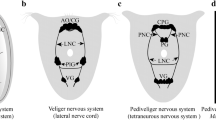Summary
Growth and regeneration of segments were recorded in the polychaeteOphryotrocha puerilis. In one experiment the ventral nerve cords (VNCs) of the animals were cut; in the other, VNCs were left intact. VNC lesion in some specimens resulted in the outgrowth of supernumerary posterior parts from the site of operation. The characteristics of outgrowth of these supernumeraries were essentially the same as in normal specimens without double tails. After removing different numbers of caudal setigers, each of the two tails of the same double-tail monster independently regenerated different segment numbers within a given time. A simple model is proposed, allowing for these results, which states that the larval body of a polychaete consists of two regions with completely different positional values (episphere — prostomium; hyposphere — pygidium). During growth, segments with intervening positional values are intercalated. The rate of segment formation is high when there is a wide gap in positional values between pygidium and adjoining budding zone and the posteriormost segment. As this gap narrows, the growth rate slows down. During caudal regeneration, first of all a new pygidium with an adjacent proliferation zone is formed and the original positional value of the posteriormost part of the body is reestablished. Segment regeneration follows the same rules as segment growth. The results presented here also demonstrate that the VNC plays an important role, not only in segment proliferation, but also in signalling positional information to the newly formed segments.
Similar content being viewed by others
References
Boilly B (1974) Mode d'action du cerveau sur la régénération caudale deNereis diversicolor O.F. Müller (Annélide Polychète). Wilhelm Roux's Arch 174:195–209
Boilly B (1977) Polarité dorso-ventrale et régénération chez les Néréidiens. Bull Soc Zool Fr 101:95–99
Boilly B, Boilly-Marer Y, Combaz A (1975) Données morphologiques et anatomiques sur quelques cas de dédoublement chez les Nereidae: Interprétation morphogénétique. Wilhelm Roux's Arch 178:139–156
Bryant SV, French V, Bryant PJ (1981) Distal regeneration and symmetry. Science 212:993–1002
Combaz A (1974) Sur le rôle de la chaîne nerveuse dans la régénération caudale des Nereidae (Annélide Polychètes). Arch Zool Exp Gén 115:293–315
Combaz A, Boilly B (1974) Etude expérimentale et histlogique de la régénération caudale en l'absence de chaine nerveuse chez les Nereidae (Annélide Polychètes). Ann Embryol Morphol 7:171–197
Daly JM (1973) Segmentation, autotomy and regeneration of lost posterior segments inHarmothoe imbricata L. (Polychaeta: Polynoidae). Maori Ora 1:17–28
French V, Bryant PJ, Bryant SV (1976) Pattern regulation in epimorphic fields. Science 193:969–981
Hill SD (1972) Caudal regeneration in the absence of a brain in two species of sedentary polychaetes. J Embryol Exp Morphol 28:667–680
Hofmann DK (1966) Untersuchungen zur Regeneration des Hinterendes beiPlatynereis dumerilii (Audouin et Milne-Edwards) (Annelida, Polychaeta). Zool Physiol 72:374–430
Hofmann DK (1969) Untersuchungen über die Regeneration des Prostomiums und des Hinterendes beim PolychaetenEunice viridis Gray. Zool Anz [Suppl] 33:253–260
Hofmann DK (1974) Maturation, epitoky and regeneration in the polychaeteEunice siciliensis under field and laboratory conditions. Mar Biol 25:149–161
Meinhardt H (1983) A boundary model for pattern formation in vertebrate limbs. J Embryol Exp Morphol 76:115–137
Olive PJW, Moore FR (1975) Hormone independent regeneration inEulalia viridis (Polychaeta: Phyllodocidae). Gen Comp Endocrinol 28:454–460
Pfannenstiel HD (1973a) Zur sexuellen Differenzierung vonOphryotrocha puerilis (Polychaeta: Eunicidae). Mar Biol 20:245–258
Pannenstiel HD (1973b) Der MeeresborstenwurmOphryotrocha puerilis. Ein ideales Labortier. Mikrokosmos 62:97–100
Pfannestiel HD (1973c) Anteriore und caudale Regeneration bei dem proterandrischen PolychaetenOphryotrocha puerilis Clap. Mecz. Wilhelm Roux's Arch 172:223–230
Pfannenstiel HD (1974) Regeneration in the gonochoristic polychaeteOphryotrocha notoglandulata, Mar Biol 24:269–272
Röhrkasten A (1983) Untersuchungen zur Regeneration des Hinterendes beiAnaitides mucosa (Polychaeta, Phyllodocidae). Heigoländer Meeresunters 36:223–229
Author information
Authors and Affiliations
Rights and permissions
About this article
Cite this article
Pfannenstiel, HD. The ventral nerve cord signals positional information during segment formation in an annelid (Ophryotrocha puerilis, Polychaeta). Wilhelm Roux' Archiv 194, 32–36 (1984). https://doi.org/10.1007/BF00848951
Received:
Accepted:
Issue Date:
DOI: https://doi.org/10.1007/BF00848951




